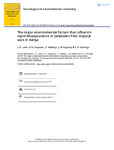| dc.description.abstract | Results of field and laboratory studies on adsorption/desorption, leaching, dissipation, bound residue formation and metabolism of DDT, DDE, lindane, parathion, malathion, dimethoate and carbofuran in tropical soils in various regions in Kenya are summarized in this paper. Based on reported half-lives of dissipation in temperate soils, DDT, DDE and lindane were found to dissipate much more rapidly in tropical soil conditions with half-lives of dissipation of 64.5-245.6, 145 and 5-8 days, respectively. Carbofuran (t1/2 = 66-115.5 days), malathion (t1/2 = 36.7-770 days), parathion (t1/2 = 48days) and dimethoate (t1/2 = 72 days) were also less persistent. The major environmental factors, wind, rainfall, solar radiation intensity and soil moisture content that contributed to this rapid disappearance are presented, explaining also the influence of important soil characteristics such as pH, % organic carbon, texture and microbial activity on pesticide distribution and degradation in soil. | en_US |

